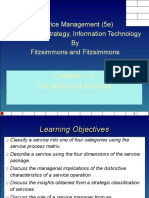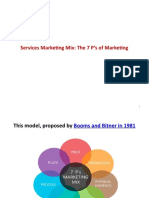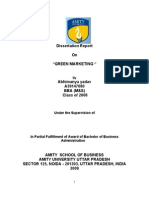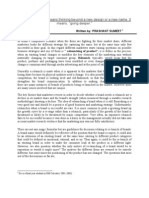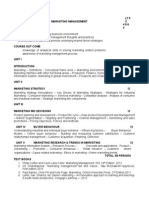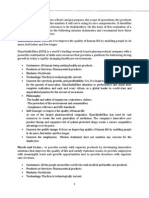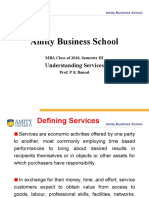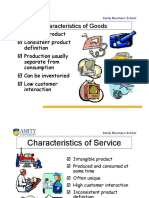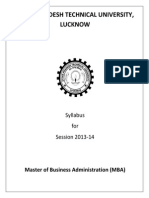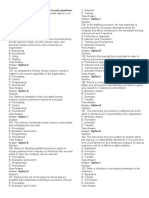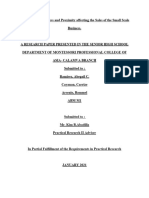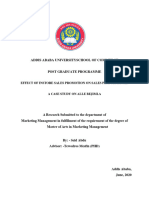Amity School of Business
Amity School of Business
Services Marketing
Module - I Ms. Manita Matharu
1
�Amity School of Business
Module I
Services an Overview
�Amity School of Business
There are no such thing as service industries.There are only industries whose service components are greater or less than those of other industries. Everybody is in service.
-Theodore Levitt-
�Amity School of Business
What is a Service ?
A Services is an act or performance offered by one party to another. Although the process may be tied to a physical product, the performance is transitory, often intangible, and does not normally result in ownership of any of the factors of production. A service is an economic activity that creates values and provides benefits for customers at specific times and places by bringing about a desired change in, or on behalf of, the recipient of the service.
�Amity School of Business
The service sector
The services sector has been growing at a rate of 8% per annum in recent years More than half of our GDP is accounted for from the services sector This sector dominates with the best jobs, best talent and best incomes
�Amity School of Business
Industries in Services
Hospitality Insurance Entertainment Telecommunication Banking Airlines Health care Travel & Tourism
�Amity School of Business
More Examples
Health Care hospital, medical practice, dentistry, eye care Professional Services accounting, legal, architectural Financial Services banking, investment advising, insurance Hospitality restaurant, hotel/motel, bed & breakfast, ski resort, rafting Travel airlines, travel agencies, theme park Others: hair styling, pest control, plumbing, lawn maintenance, counseling services, health club
�Amity School of Business
Reasons for the Growth of Service Industry
Changing Lifestyle Increase in affluence (Dry-cleaning, carpet cleaning) Increase in leisure time (Travel resorts, agencies, entertainment, discos) Women in working places (Daycare nurseries, home help, away home meals, baby sitting) Changing World Increasing complexity of life (Accounting services, marriage counselors, legal advisors) Increased life expectancies (Health clubs, health care services, Gyms) Ecology & Resource concerns (Chartered bus service, point-to-point shared taxi service, environmental consultants)
8
�Amity School of Business
Reasons for the Growth of Service Industry
Changing Economies Globalization (courier service) Privatization/Deregulation (telecom service)
Changing Technology Range of new products (E-commerce) Product complexity (Annual maintenance contracts)
�Amity School of Business
Distinctive aspects of Service Management
Marketing of Services verses Physical Goods No Customer Ownership of Services Service Products as Intangible Performances Customer Involvement in the Production Process
People as Part of the Product
Greater Variability in Operational Inputs & Outputs Difficulty in Customer Evaluation No Inventories for Services after Production Importance of the Time factor Different distribution channels
10
�Amity School of Business
S. No.
Physical Goods Tangible Homogeneous Product and distribution separated from consumption A thing Core value produced in factory Intangible
Services Heterogeneous Production, distribution and consumption re simultaneous process A activity Core value produced in buyerseller interaction
1. 2. 3.
4. 5. 6. 7. 8.
Customers do not participate in Customers participate in the production process production Can be kept in stock Transfer of ownership Cannot be kept in stock No transfer of ownership
11
�Amity School of Business
The Goods-Services Continuum
Canned Ready- AutoDraperies, RestRepairs: Air foods made mobiles Carpets aurant auto, house, travel clothes meals landscaping
Insurance, Consulting, Teaching
MOSTLY GOODS
MOSTLY SERVICES
12
�Amity School of Business
Tangibility Spectrum
Salt
Soft Drinks Detergents Automobiles Cosmetics Fast-food Outlets
Fast-food Outlets
Intangible Dominant
Tangible Dominant
Advertising Agencies Airlines Investment Management Consulting
Teaching
13
�Amity School of Business
Services Needs & Product as a consequence
Age (old care) -> senior citizens homes, wheel chairs Dental care -> Dental chairs, dental equipment Dieting services -> low fat food Eye care -> eye care glasses, computerized eye testing machines Pollution control -> pollution monitoring machines, filters for air/water Hospitals -> Medicines, medical equipments Hair Styling -> Hair fixing, coloring, shaping products, driers Mental health services -> Brain scanners Skin care services -> skin care products Astrological services -> Horoscopes, astrology books Photograph -> video cameras, films Cable TV -> Dish antennas Copying services -> Photocopiers, fax machines Courier services -> Vehicles
14
�Amity School of Business
Characteristics of Services
Intangibility
Heterogeneity
Simultaneous Production and Consumption
Perishability
15
�Amity School of Business
Services are Different
Goods
Tangible
Services
Intangible
Resulting Implications
Services cannot be inventoried. Services cannot be readily displayed or communicated. Pricing is difficult.
Standardized
Heterogeneous Service delivery and customer satisfaction depend on employee actions. Service quality depends on many uncontrollable factors. There is no sure knowledge that the service delivered matches what was planned and promoted. Simultaneous production and consumption Customers participate in and affect the transaction. Customers affect each other. Employees affect the service outcome. Decentralization may be essential. Mass production is difficult. It is difficult to synchronize supply and demand with services. Services cannot be returned or resold.
Production separate from consumption
Nonperishable Perishable
Source: Adapted from Valarie A. Zeithaml, A. Parasuraman, and Leonard L. Berry, Problems and Strategies in Services Marketing, Journal of Marketing 49 (Spring 1985): 33-46.
16
�Amity School of Business
5 IS of Services
Intangibility Inconsistency Inseparability Inventory Involvement
17
�Amity School of Business
Reading Assignment for the Next Class
Write a brief note on eco tourism and medical tourism. How do they qualify to service industry?
18
�Amity School of Business
The Services Marketing Triangle
Company (Management)
Internal Marketing
enabling the promise
External Marketing
setting the promise
Employees
Interactive Marketing
delivering the promise
Customers
Source: Adapted from Mary Jo Bitner, Christian Gronroos, and Philip Kotler
19
�Amity School of Business
The Services Triangle and Technology Company
Technology
Providers
Source: Adapted from A. Parasuraman
Customers
20
�Amity School of Business
An Integrated Approach to Service Management Eight Components of Integrated Service Management
Product Element Place, Cyberspace, and Time Process Productivity and Quality People Promotion and Education Physical Evidence
Price and Other User Costs
21
�Amity School of Business
Traditional Marketing Mix
All elements within the control of the firm that communicate the firms capabilities and image to customers or that influence customer satisfaction with the firms product and services:
Product Price Place Promotion
�Amity School of Business
Expanded Mix for Services -- the 7 Ps
Product Price Place Promotion
People Process Physical Evidence
�Amity School of Business
Expanded Marketing Mix for Services
PRODUCT PLACE PROMOTION PRICE
Promotion blend Salespeople Advertising Flexibility
Physical good Channel type features Quality level Accessories Packaging Warranties Product lines Branding Exposure Intermediaries
Price level Terms Differentiation Allowances
Outlet location Sales promotion Transportation Publicity Storage
24
�Amity School of Business
Expanded Marketing Mix for Services (Continued)
PEOPLE
Employees Customers Communicating culture and values Employee research
PHYSICAL EVIDENCE
Facility design Equipment Signage Employee dress Other tangibles
PROCESS
Flow of activities Number of steps Level of customer involvement
25
�Amity School of Business
Classification of Different Types of Services
1. Classification of Services by Industry 2. Classification of Services by Target Effect 3. Classification of Services by Customer Experience
26
�Amity School of Business
Classification of Different Types of Services
Classification of Services by Industry
Entertainment Industry Hospitality Industry Trading Finance & Insurance Education Transportation Public utilities Government services Health Business services Telecommunications
27
�Amity School of Business
Classification of Different Types of Services
Classification of Services by Target Effect
Services aimed at physical care
Such as health care, beauty salons, clinics, gymnasiums and restaurants
Services for intangible assets
Such as banking, legal consultation, accounting, brokering and insurance
Services aimed at the mind of the customer
Such as education, broadcasting, information, entertainment and amusement.
Services aimed at physical possessions and tangible assets
Such as transport, repair and maintenance, cleaning and janitorial, laundry, gardening and veterinary services.
28
�Amity School of Business
Classification of Different Types of Services
Classification of Services by Customer Experience Services purchase requiring Extensive Planning
A couple planning to celebrate their 25th wedding anniversary in grand style. Overseas vacation (SOTC and Thomas cook)
Services dependent on Customer Experiences
Gymnasium, Spa or sauna bath, fast food restaurant or pizza parlour
Services based on Trust
Patient and a surgeon
29
�Amity School of Business
Four Rs of Service Marketing
Retention Referrals Relationships Recovery
30
�Amity School of Business
Services in India
The various sectors that combine together to constitute service industry in India are:
Trade Hotels and Restaurants Railways Other Transport & Storage Communication (Post, Telecom) Banking Insurance Real Estate Business Services Public Administration Community Services Other Services
31
�Amity School of Business
Growth of Services in India
Service Sector in India today accounts for more than half of India's GDP. According to data for the financial year 2006-2007, the share of services, industry, and agriculture in India's GDP is 55.1 per cent, 26.4 per cent, and 18.5 per cent respectively.
The fact that the service sector now accounts for more than half the GDP marks a watershed in the evolution of the Indian economy and takes it closer to the fundamentals of a developed economy. Services or the "tertiary sector" of the economy covers a wide gamut of activities like trading, banking & finance, infotainment, real estate, transportation, security, management & technical consultancy among several others.
32
�Amity School of Business
The Changing Environment for Services
The boom in the service economy, reduced regulation has created an increase in competition. Major focus on increased productivity, efficiency Work on people aspects of business: Education, training programs Change technology: Computer-based technologies used. Restructure jobs. Bottom line: People are key to success!
33
�Amity School of Business
Other Considerations in Marketing Services
Impact of Technology: Remember, not everyone likes impersonal technology Performance Measurement: Larger firms can use market share, etc. Customer perceptions are essential. Prospects for Growth: It is very likely that services will continue to take an increasing share of the consumer dollar. The use of marketing programs in all services is expected to increase considerably.
34









